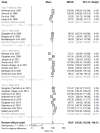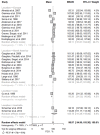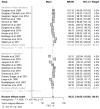The Effect of Fire Smoke Exposure on Firefighters' Lung Function: A Meta-Analysis
- PMID: 36554677
- PMCID: PMC9779288
- DOI: 10.3390/ijerph192416799
The Effect of Fire Smoke Exposure on Firefighters' Lung Function: A Meta-Analysis
Abstract
Firefighters are exposed to a range of harmful substances during firefighting. Exposure to fire smoke has been associated with a decrease in their lung function. However, the cause-effect relationship between those two factors is not yet demonstrated. This meta-analysis aimed to evaluate the potential associations between firefighters' occupational exposure and their lung function deterioration. Studies were identified from PubMed, Web of Science, Scopus and Science Direct databases (August 1990-March 2021). The studies were included when reporting the lung function values of Forced Expiratory Volume in 1 s (FEV1) or Forced Vital Capacity (FVC). The meta-analyses were performed using the generic inverse variance in R software with a random-effects model. Subgroup analysis was used to determine if the lung function was influenced by a potential study effect or by the participants' characteristics. A total of 5562 participants from 24 studies were included. No significant difference was found between firefighters' predicted FEV1 from wildland, 97.64% (95% CI: 91.45-103.82%; I2 = 99%), and urban fires, 99.71% (95% CI: 96.75-102.67%; I2 = 98%). Similar results were found for the predicted FVC. Nevertheless, the mean values of firefighters' predicted lung function varied significantly among studies, suggesting many confounders, such as trials' design, statistical methods, methodologies applied, firefighters' daily exposure and career length, hindering an appropriate comparison between the studies.
Keywords: FVC and FEV1; firefighters; lung function; meta-analysis; occupational exposure.
Conflict of interest statement
The authors declare no conflict of interest.
Figures






Similar articles
-
Lung function changes in wildland firefighters working at prescribed burns.Inhal Toxicol. 2011 Nov;23(13):835-41. doi: 10.3109/08958378.2011.617790. Inhal Toxicol. 2011. PMID: 22035123
-
Occupational exposure of firefighters to hazardous pollutants during prescribed fires in Portugal.Chemosphere. 2024 Mar;352:141355. doi: 10.1016/j.chemosphere.2024.141355. Epub 2024 Feb 7. Chemosphere. 2024. PMID: 38331261
-
High hsCRP is associated with reduced lung function in structural firefighters.Am J Ind Med. 2014 Jan;57(1):31-7. doi: 10.1002/ajim.22260. Epub 2013 Sep 20. Am J Ind Med. 2014. PMID: 24115029 Free PMC article.
-
In vitro data for fire pollutants: contribution of studies using human cell models towards firefighters' occupational.J Toxicol Environ Health B Crit Rev. 2023 May 19;26(4):238-255. doi: 10.1080/10937404.2023.2187909. Epub 2023 Mar 8. J Toxicol Environ Health B Crit Rev. 2023. PMID: 36883725 Review.
-
Firefighters' Clothing Contamination in Fires of Electric Vehicle Batteries and Photovoltaic Modules-Literature Review and Pilot Tests Results.Int J Environ Res Public Health. 2022 Sep 29;19(19):12442. doi: 10.3390/ijerph191912442. Int J Environ Res Public Health. 2022. PMID: 36231742 Free PMC article. Review.
Cited by
-
Exploring the use of masks for protection against the effects of wildfire smoke among people with preexisting respiratory conditions.BMC Public Health. 2023 Nov 24;23(1):2330. doi: 10.1186/s12889-023-17274-3. BMC Public Health. 2023. PMID: 38001501 Free PMC article.
-
The Puzzle of Marijuana Use and Forced Vital Capacity.Ann Am Thorac Soc. 2024 May;21(5):683-691. doi: 10.1513/AnnalsATS.202312-1010CME. Ann Am Thorac Soc. 2024. PMID: 38271695 Free PMC article. Review.
-
Work Exposome and Related Disorders of Firefighters: An Overview of Systematized Reviews.Saf Health Work. 2025 Jun;16(2):145-155. doi: 10.1016/j.shaw.2025.04.003. Epub 2025 Apr 23. Saf Health Work. 2025. PMID: 40575691 Free PMC article. Review.
-
Firefighters' occupational exposure to air pollution: impact on COPD and asthma-study protocol.BMJ Open Respir Res. 2024 Nov 20;11(1):e001951. doi: 10.1136/bmjresp-2023-001951. BMJ Open Respir Res. 2024. PMID: 39572082 Free PMC article.
-
Determinants of Health and Performance in Wildland Firefighters: A Narrative Review.J Funct Morphol Kinesiol. 2025 Feb 27;10(1):80. doi: 10.3390/jfmk10010080. J Funct Morphol Kinesiol. 2025. PMID: 40137332 Free PMC article. Review.
References
-
- Miranda A.I., Martins V., Cascão P., Amorim J.H., Valente J., Borrego C., Ferreira A.J., Cordeiro C.R., Viegas D.X., Ottmar R. Wildland Smoke Exposure Values and Exhaled Breath Indicators in Firefighters. J. Toxicol. Environ. Health A. 2012;75:831–843. doi: 10.1080/15287394.2012.690686. - DOI - PubMed
Publication types
MeSH terms
Substances
LinkOut - more resources
Full Text Sources
Medical

